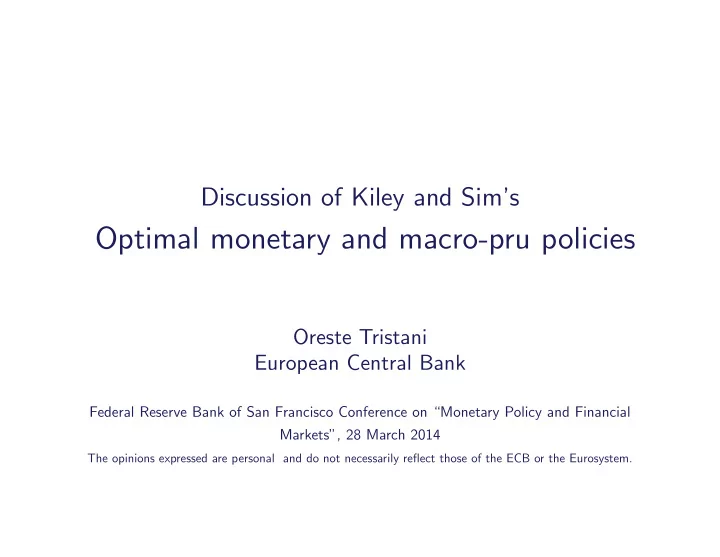

Discussion of Kiley and Sim’s Optimal monetary and macro-pru policies Oreste Tristani European Central Bank Federal Reserve Bank of San Francisco Conference on “Monetary Policy and Financial Markets”, 28 March 2014 The opinions expressed are personal and do not necessarily reflect those of the ECB or the Eurosystem.
Summary • One of the first papers on a new macro topic: optimal mone- tary and macro-prudential policy • “A quantitative model”: need to provide guidance in discus- sions of specific macroprudential instruments • Can simple rules approximate optimal policy?
Three questions/suggestions • Why macro-prudential policy? • Why dilution costs? • Which results are useful from the applied policy perspective?
Why macroprudential policy • To reduce the likelihood of new financial crises. An ex-ante response to risks (not expectations) • Main concern: excessive (eg. due to deposit insurance) lever- age/risk taking leading to fragility • Macro-prudential tools better suited to reduce excessive risk taking. Monetary policy would face a trade-off
Why macroprudential policy • To help set macroprudential tools, the paper should focus more on the ex-ante dimension: Is leverage lower on average with the leverage tax? Is consumption volatility lower? Are there trade-offs without the leverage tax?
Why macroprudential policy • To help set macroprudential tools, the paper should focus more on the ex-ante dimension: Is leverage lower on average with the leverage tax? Is consumption volatility lower? Are there trade-offs without the leverage tax? • In the model can leverage be excessive ex-ante?
Why macroprudential policy • No trade-off for monetary policy. • Are welfare gains only ex-post?
Why macroprudential policy • To help set macroprudential tools, the paper should focus more on the ex-ante dimension: Is leverage lower on average with the leverage tax? Is consumption volatility lower? Are there trade-offs without the leverage tax? • In the model can leverage be excessive ex-ante? • If not, promise ex-post credit policy?
Why dilution costs? • Kiley and Sim: no explicit leverage constrains, but cost to raise equity when needed. Banks react ex-ante to risk of having to raise capital. Compare to: — Gertler and Karadi: high leverage constrains banks’ ability to borrow (deposits) — He and Krishnamurthy (also Dewachter and Wouters): high leverage constrains banks’ ability to raise outside equity
Why dilution costs? • Some evidence in favour of the KS friction would be desirable. — Model has both time series and cross-sectional implications for banks’ equity issuance and dividend payments. E.g. banks should pay dividends also during recessions; dividends should fall after "financial recession"; equity issuance should increase at times of high funding uncertainty
Net corporate dividend payments 1,000 900 800 (Billions of Dollars) 700 600 500 400 300 200 100 1990 1995 2000 2005 2010 Source: U.S. Department of Commerce: Bureau of Economic Analysis Shaded areas indicate US recessions - 2014 research.stlouisfed.org
Equity issuance in the corporate financial sector 20,000 24 Number of issuances (rhs) 18,000 New Shares Volume (euro mill.) 20 16,000 14,000 16 12,000 10,000 12 8,000 8 6,000 4,000 4 2,000 0 0
Why dilution costs? • Some evidence in favour of the KS friction would be desirable. — Model has both time series and cross-sectional implications for banks’ equity issuance and dividend payments — Were dilution costs a key constraint during the recent crisis?
Why dilution costs? • Some evidence in favour of the KS friction would be desirable. — Model has both time series and cross-sectional implications for banks’ equity issuance and dividend payments — Were dilution costs a key constraint during the recent cri- sis? — Basic model properties: are lending spreads countercycli- cal? Is leverage pro-cyclical or counter-cyclical?
Why dilution costs? • Dilution costs are realistic, but is the mechanism in the paper of first order importance for macro-dynamics? • Is net worth a state variable? How long does high leverage last? • No accelerator properties?
Constraints from the applied policy perspective • Which tax/subsidy works best as a macroprudential tool? • Specific macro-prudential tool taken as given here. But is the "realism constraint" too tight? — welfare penalty on interest rate changes — could the regulator not react to "changes in leverage judged to be excessive"?
Summary • One of the first contributions to a new literature • F ocus more on the ex ante properties of optimal policy • Clarify propagation mechanism and provide some evidence in support of the macro-relevance of dilution costs
Recommend
More recommend